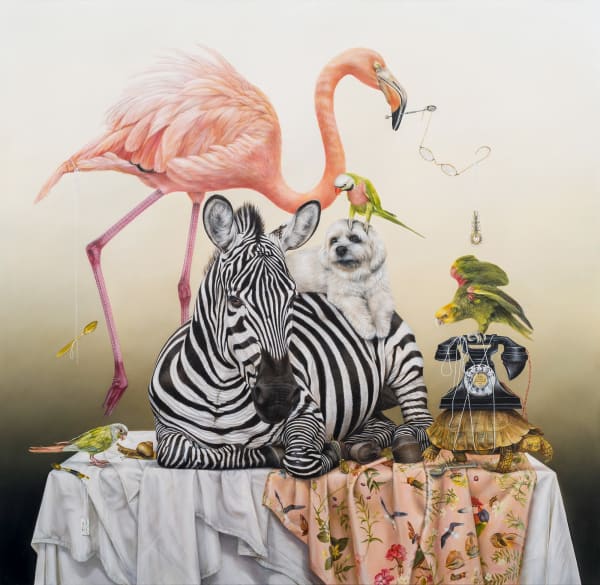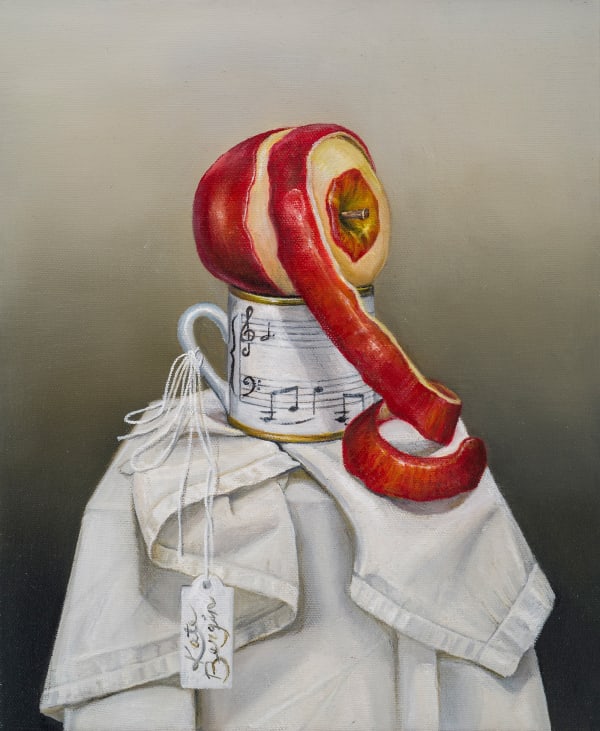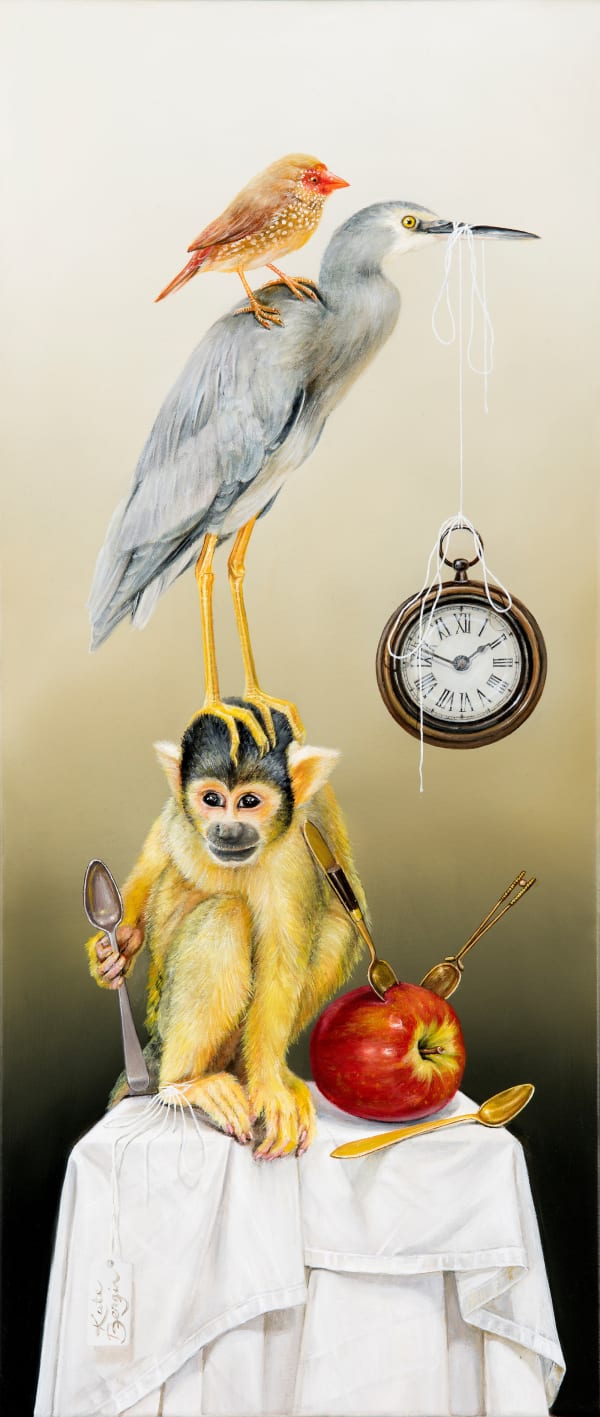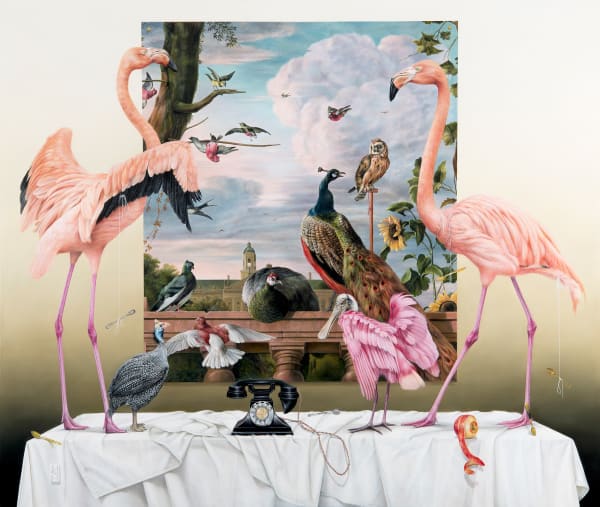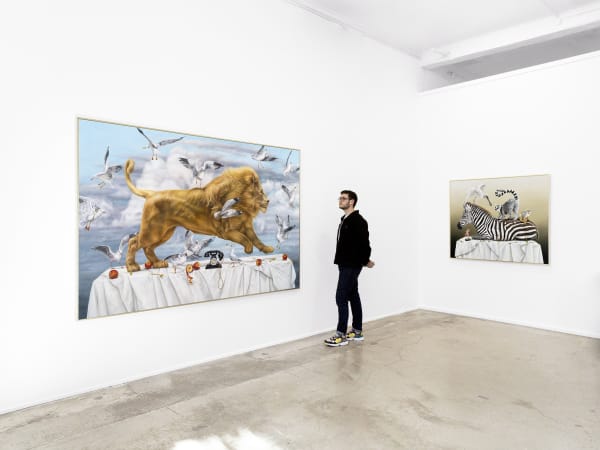Kate Bergin: Tabletop Variations
-
 Kate BerginA Complicated Arrangement, 2019oil on canvas90 x 80 cm, 93 x 83 cm (framed)
Kate BerginA Complicated Arrangement, 2019oil on canvas90 x 80 cm, 93 x 83 cm (framed) -
 Kate BerginArabesque, 2019oil on canvas150 x 130 cm, 153 x 133 cm (framed)
Kate BerginArabesque, 2019oil on canvas150 x 130 cm, 153 x 133 cm (framed) -
 Kate BerginBalancing Act, 2018oil on canvas150 x 155 cm, 153 x 158 cm (framed)
Kate BerginBalancing Act, 2018oil on canvas150 x 155 cm, 153 x 158 cm (framed) -
 Kate BerginGossip, 2019oil on canvas150 x 130 cm, 153 x 133 cm (framed)
Kate BerginGossip, 2019oil on canvas150 x 130 cm, 153 x 133 cm (framed) -
 Kate BerginMoon River, 2018oil on canvas30.5 x 25 cm, 33.5 x 38 cm (framed)
Kate BerginMoon River, 2018oil on canvas30.5 x 25 cm, 33.5 x 38 cm (framed) -
 Kate BerginPatience and Temptation, 2019oil on canvas90 x 80 cm, 93 x 83 cm (framed)
Kate BerginPatience and Temptation, 2019oil on canvas90 x 80 cm, 93 x 83 cm (framed) -
 Kate BerginShared Interests, 2019oil on canvas40 x 30 cm, 43 x 33 cm (framed)
Kate BerginShared Interests, 2019oil on canvas40 x 30 cm, 43 x 33 cm (framed) -
 Kate BerginTall Tales, 2018oil on canvas203 x 185 cm, 206 x 188 cm (framed)
Kate BerginTall Tales, 2018oil on canvas203 x 185 cm, 206 x 188 cm (framed) -
 Kate BerginThe Curlew's Call, 2019oil on canvas90 x 80 cm, 93 x 83 cm (framed)
Kate BerginThe Curlew's Call, 2019oil on canvas90 x 80 cm, 93 x 83 cm (framed) -
 Kate BerginThe Interlopers, 2019oil on canvas135 x 135 cm, 138 x 138 cm (framed)
Kate BerginThe Interlopers, 2019oil on canvas135 x 135 cm, 138 x 138 cm (framed) -
 Kate BerginThe Playroom, 2019oil on canvas120 x 140 cm, 123 x 143 cm (framed)
Kate BerginThe Playroom, 2019oil on canvas120 x 140 cm, 123 x 143 cm (framed) -
 Kate BerginThe Shimmering Space, 2019oil on canvas153 cm x 173 cm (framed)Sold
Kate BerginThe Shimmering Space, 2019oil on canvas153 cm x 173 cm (framed)Sold -
 Kate BerginThe Toucan's Mobile Phone, 2019oil on canvas70 x 50 cm, 73 x 53 cm (framed)
Kate BerginThe Toucan's Mobile Phone, 2019oil on canvas70 x 50 cm, 73 x 53 cm (framed) -
 Kate BerginThe Trouble With Tigers and Teaspoons, 2017oil on canvas70 x 50 cm, 74 x 54 cm (framed)
Kate BerginThe Trouble With Tigers and Teaspoons, 2017oil on canvas70 x 50 cm, 74 x 54 cm (framed) -
 Kate BerginThe Unlikely Spoon Collector, 2019oil on canvas30 x 40 cm, 33 x 43 cm (framed)
Kate BerginThe Unlikely Spoon Collector, 2019oil on canvas30 x 40 cm, 33 x 43 cm (framed) -
 Kate BerginTime Keepers and Temptation Seekers, 2019oil on canvas70 x 30 cm, 73 x 33 cm (framed)
Kate BerginTime Keepers and Temptation Seekers, 2019oil on canvas70 x 30 cm, 73 x 33 cm (framed) -
 Kate BerginVisiting the Palace of Amsterdam (Featuring Melchior De Hondecoeter's Palace of Amsterdam With Exotic Birds, C. 1660), 2019oil on canvas170 x 200 cm, 173 x 203 cm (framed)
Kate BerginVisiting the Palace of Amsterdam (Featuring Melchior De Hondecoeter's Palace of Amsterdam With Exotic Birds, C. 1660), 2019oil on canvas170 x 200 cm, 173 x 203 cm (framed)
The virtuosic paintings of artist Kate Bergin take the viewer on a playful expedition through the absurd and the profound. Strange gatherings of animals and objects are configured in impossible scenarios on the brink of collapse atop tables draped with white cloth, alluding to the conventions of seventeenth century Dutch and Flemish still life painting. Yet Bergin’s compositions are far from ‘still’. They pulsate with movement as animals prepare to leap from the canvas and birds take flight, and yet these moments are frozen in time like mimetic dioramas. It is in this dialogue between stasis and motion, stability and precariousness, that the artist seeks to find, in her own words, ‘balance and imbalance, contemplation within the chaotic and playfulness with a touch of menace – just like any good fairy-tale.’
‘Tabletop Variations’ continues Bergin’s focus on the symbolic currency of the ‘un-still life’. The title of the exhibition alludes to Bach’s The Goldberg Variations – a frequent accompaniment in the artist’s studio. ‘The series of diverse melodies unified by a single bass line and chordal structure reflects my own approach to composition’, explains Bergin. ‘These tabletop variations transpose the musical form onto the visual plane, the tabletop providing the ‘bass line’ and the birds, animals and various objects becoming the ‘variations’.’
The paintings visualise the artist’s passionate fascination with animals of all kinds. Displaced from their usual habitats, various species from different continents coexist peacefully in each tabletop tableaux; a poignant image of acceptance and harmony in a world pivoted on segregation. Telephones, teaspoons and spectacles function as visual metonyms for ‘civilised’ society, perhaps signalling the frontier that humans have constructed to elevate ourselves above the animal kingdom. Bergin’s animals chisel a chink in this armature of civilisation, evoking the wilderness that dwells beneath.
Bergin builds each painting around a central character, the tabletop acting as a stage upon which she moves creatures around to create a believable space with convincing relationships. Working from her own photographs as well as from life, she ensures that each animal retains its own identity without becoming too anthropomorphised. Together, the works in ‘Tabletop Variations’ represent a voyage through art history. ‘This is the joy of art history and our connection to it as painters today,’ reflects Bergin, ‘the circles within circles, the threads that lead you in and out and around, dizzying in all its contrary symbolism.’


